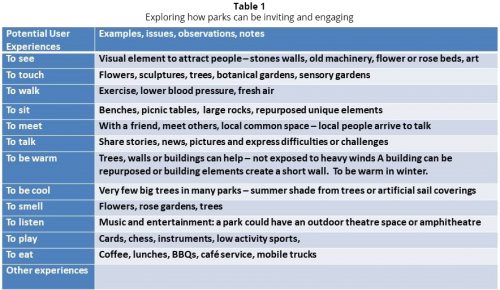A park is more than its name

How to design inclusive parks for seniors and the elderly
The key to problem solving is matching the process to the challenge: a short-term challenge needs a short-term solution, while a long-term challenge needs a long-term solution.
The design of a park is a very long-term challenge. Many parks share the same problem: they’re rarely used. Typically, they’re a community park in name only:
- They’re a softball park with a playground.
- They have few benches and no attractions.
- They have a paved path but no place to sit, meet, or play.
How successful is community park design now? Good design is hard to measure. At a minimum, are parks used? Research by the National Study of Neighborhood Parks1 found that most community parks are underused. There are a variety of tools that can prompt new insights and ideas. This article provides several steps that any city could use to improve the quality and creativity of ideas to make parks more appealing and useful to seniors and the elderly.
Finding Perspective
To start, an innovation truism creates a useful perspective: how you define the challenge (or problem) will dictate your result. Therefore, is the challenge:
- creating a 17-acre community park, or
- exploring what park is possible with 17 acres and $4 million?
The first option is basic problem solving. The second option is an innovation challenge. Let’s assume you have a diverse team to explore ideas. They need some training to understand collaboration and problem solving. Training helps generates more ideas while reducing conflict.
Using a basic innovation process instills a discipline to shape the park opportunity. The process begins with a bold challenge to go beyond the self-imposed limits of experience. Consider building a landmark to set a high standard.
An Innovative Process
The following four provocations are provided to prompt insight and ideas.
1. How could various city policies be advanced?
Explore various city policies to see how the park could achieve an objective:
- Age-friendly policies create opportunities for people of all ages and abilities.
- Urban forest policies build the canopy of trees, turning some of the park into forest.
- Tourism policies include sophisticated elements such as a botanical or rose gardens.
- Arts and cultural policies lead to public art, performances, concerts, or sculptures.
Big ideas could take years (a botanical garden or urban forest), while others can be built now (an outdoor theatre).
2. Create additional funding for innovative ideas
KPMG provided the following suggestions:
- Identify ways to leverage city space to generate revenue.
- Review the service delivery model for economic development.
- Sell naming rights and explore sponsorship and advertising opportunities.
Parks might benefit from a park sponsorship strategy. Could a sponsor support or build an outdoor theatre, grandstand, or washroom? Could the park generate revenues with a café while giving seniors a place to go?
3. Imitate an idea for seniors
Many municipalities upgrade parks by installing playground systems. Playgrounds are like an island of activity in a big green space. This begs a question: Could we create “islands of activity” for seniors within any park? (To clarify, this does not mean an adult playground or exercise equipment.)
Questions to consider include:
- How could an “island of activity” park system create opportunities for seniors and the elderly with a range of physical, social, and mental capabilities?
- How could this system be designed, installed, and replicated in many parks?
At a practical level, this may be several benches grouped together, a game table, something to attract attention (art or sculptures), lighting, and trees or large sails for shade and protection. A large park could host several islands, but lots of design, experimenting, and testing is needed.
4. Consider the user experience
The proportion of seniors is growing. What experiences could an island of activity deliver for seniors? What they can experience in a park is only limited by our imagination. Consider the following:
- How can parks be inviting and engaging?
- How does the experience we want people to have become a park element? What needs to be in place?
- What are the practical ideas that need development to build this opportunity?
- What could be created with partnerships, sponsorships, or naming rights?

Best opportunity possible for public space: Parks only have value if they are used. The design must allow for this generation, the next generation, and the next to see its value.
Opportunity for Good Design
The process above should lead to a range of experiences users can have. They translate into park elements, “islands of activity,” link to city policies, and a sponsorship strategy. The concept is rough, but it has potential. There is no blueprint, but there’s a vision and concept.
Does it live up to the attributes of a future landmark? You’ll need to gauge the aesthetic response users will have. The following can be used as design criteria:
- Vitality – Anything great has a sense of vitality. We are attracted to it. Fresh ideas revitalize us, make us feel more alive.
- Simplicity – The power of simplicity; we sense completeness, wholeness, and perfection. An elegant solution. It may take time to create, but it will endure and serve us best.
- Utility – It delights us. We love when something meets a real need. We are drawn toward those things. Form fits function. We value this over time.
We want users to arrive at a park and feel excited. They look around, and it makes sense to them. It serves all users. We want people to talk about it with pride and recommend it.
When this planning process is over, we have defined the best opportunity possible for the public space. It’s a vision to create the blueprints and design elements of a park. The innovation process is about exploring what is possible. You can always go back to the old ways of park design. Yet, if you create one or two useful ideas from the process, it will be a better park.
Parks only have value if they are used. Starting with a challenge to be landmark for the city in 25, 50, or even 100 years means you must go beyond the basics. Parks evolve over time. The design must allow for this generation, the next generation, and the next to see its value. MW
1 National Study of Neighborhood Parks, “Active Parks, Healthy Cities: Recommendations from the National Study of Neighborhood Parks,” https://cityparksalliance.org/resource/active-parks-healthy-cities/.
✯ Municipal World Insider and Executive Members: You might also be interested in Cynthia Graham’s article: Parks are the new medicine.
Ed Bernacki helps leaders “lead” innovation by building the skills and capacities of their teams and organizations to innovate. He has a particular interest in the public sector, having worked in and with public services for many years here and overseas.
Related resource materials:



